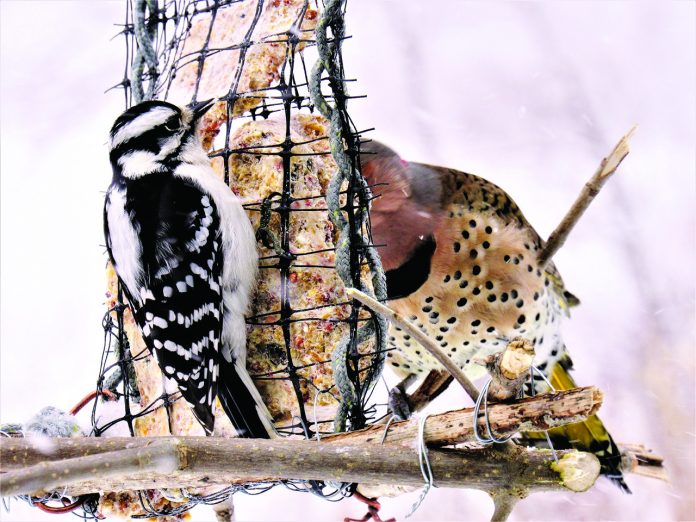Back in 1976, a Canadian ornithologist named Erica Dunn established the Ontario Bird Feeder Survey through Canada’s Long Point Bird Observatory.
After a successful 10-year run with more than 500 participants, it became apparent that only a continental survey could accurately monitor large-scale abundance, distribution, and movements of birds.
FeederWatch
At that point the observatory partnered with the Cornell Lab of Ornithology, resulting in what became Project FeederWatch.
In the winter of 1987-88, more than 4,000 people enrolled. FeederWatchers represented all 49 continental states and most Canadian provinces. The dream to survey winter feeder birds over a wide geographic range became a reality.
Project has grown
Since then, the number of participants has grown to more than 20,000 annually. FeederWatch continues to be a cooperative research project between the Cornell Lab of Ornithology and Bird Studies Canada (formerly the Long Point Bird Observatory).
Today, FeederWatch has become an effective tool for monitoring the distribution and abundance of winter birds that visit feeders at backyards, nature centers, schools, and parks.
Volunteers needed
FeederWatch begins Nov. 9 and runs through April and relies on volunteers like you. Citizen scientists periodically count birds they see at their feeders and submit the data to Project FeederWatch.
These bird counts monitor what happens in backyards and helps scientists track long-term trends in bird distribution and abundance.
“The good news is that most feeder birds are faring much better overall than other species,” says FeederWatch leader Emma Greig. “But we do see some patterns of loss in FeederWatch data. There are declines in the numbers of dark-eyed juncos and blue jays being reported, for example. These are common birds, but over time we’re seeing fewer of them.”
Anyone interested in birds can participate. FeederWatch is conducted by people of all skill levels and backgrounds. You can count birds once a week, once a month or whenever you like; the schedule is completely flexible.
New FeederWatchers are sent complete instructions for participating, as well as a bird identification poster, calendar, and more. You provide the feeder(s) and seed.
Then each fall participants receive the lab’s 16-page, year-end report, Winter Bird Highlights. Participants also receive access to the digital version of Living Bird, the Cornell Lab’s award-winning, quarterly magazine.
Supported by participants
Project FeederWatch is supported almost entirely by its participants. The annual fee ($18 for non-Cornell Lab members; $15 for Lab members) covers materials, staff support, web design, data analysis, and the year-end report.
If you’re feeding wild birds for the first time, Project FeederWatch can add real meaning to birdwatching.
Maybe a child has come home from school and asked to put up a bird feeder. Maybe you’re a recent empty nester with some spare time to fill. Or maybe you’d like to use birds to introduce your grandchildren to the natural world. In any case, joining FeederWatch is a great way to make feeding birds a more meaningful activity.
All you need to start is a bag of black-oil sunflower seed and a feeder. All seed-eating birds eat sunflower seeds, and oil seeds have a high fat content, which is valuable in cold weather.
Learn your birds
Feeding birds is also a great way to learn to identify them. Thanks to the results of more than 30 years of FeederWatch data, the species you can expect are predictable.
Assuming you have suitable habitat with at least a few scattered trees and shrubs for cover, expect 12 to 18 species over the course of the winter.
Based on data submitted from the northeast quarter of the continent, you are almost certain to attract chickadees (black-capped or Carolina, depending on your location), dark-eyed juncos, mourning doves, northern cardinals, downy woodpeckers, and blue jays. Last winter these six species visited 90% or more of FeederWatch locations in the northeast.
White-breasted nuthatches and American goldfinches visited more than 85% of the sites. Other winter species that frequent feeders in the Northeast include red-bellied woodpeckers, house finches, tufted titmice, white-throated sparrows, and Carolina wrens.
To participate, visit FeederWatch.org or call the Cornell Lab at 607-254-2427. The $18 fee ($15 for Cornell Lab members) covers all materials, data analysis, and publication of each year’s results.













